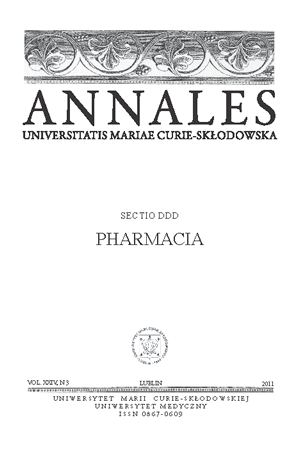Wpływ łącznego podawania leku Ukrain i tricyklicznych leków przeciwdepresyjnych na podstawowe parametry biochemiczne funkcji nerek w surowicy krwi szczurów
DOI:
https://doi.org/10.12923/Słowa kluczowe:
Ukrain, TLPD, nefrotoksyczność, szczuryAbstrakt
Celem pracy była ocena wpływu równoczesnego 10-dniowego podawania leku Ukrain oraz tricyklicznych leków przeciwdepresyjnych, tj. imipraminy (IMI) oraz amitryptyliny (AMI) na podstawowe parametry biochemiczne świadczące o funkcji nerek szczurów. W surowicy krwi zwierząt oznaczono stężenia kreatyniny, mocznika oraz β2-mikroglobuliny. W oparciu o wyniki przeprowadzonych badań stwierdzono, że 10-cio dniowe stosowanie u gryzoni leku Ukrain w kombinacji z IMI zmniejszało stężenie kreatyniny (Ukrain 28 mg/kg) a zwiększało poziom mocznika (Ukrain 14 mg/kg) w surowicy krwi. To samo połączenie leków nie wpływało na stężenie β2-mikroglobuliny. Natomiast podawanie szczurom przez 10 dni leku Ukrain w połączeniu z AMI powodowało zmniejszenie stężenia kreatyniny i mocznika (Ukrain 28 mg/kg) w surowicy krwi zwierząt. Z kolei stężenie β2-mikroglobuliny wzrastało w grupach gryzoni poddanych 10-cio dniowemu działaniu leku Ukrain (14 i 28 mg/kg) oraz AMI w porównaniu z lekiem Ukrain a obniżało się w odniesieniu do AMI. Opisane niekorzystne wahania w badanych parametrach biochemicznych w surowicy krwi szczurów mogą wskazywać ryzyko zaburzenia czynności nerek po łącznym 10-cio dniowym podaniu leku Ukrain z tricyklicznymi lekami przeciwdepresyjnymi, co może okazać się przydatne w praktyce klinicznej.
Bibliografia
1. Ahmed Khan M. I. et al.: Opioid and Adjuvant Analgesics: Compared and Contrasted. Am. J. Hosp. Palliat. Care, 2011 May 26 (Epub ahead of print).
2. Danysz A. et al.: Clinical studies of Ukrain in healthy volunteers (phase 1). Drugs Exptl. Clin. Res., 18, 39, 1992.
3. Dharmshaktu P. et al.: Efficacy of Antidepressants as Analgesics: A Review. J. Clin. Pharmacol., 2011 Mar 17 (Epub ahead of print).
4. Dworkin R. H. et al.: Recommendations for the pharmacological management of neuropathic pain: an overview and literature update. Mayo Clin. Proc., 85, S3, 2010.
5. Gansauge F. et al.: The clinical efficacy of adjuvant systemic chemotherapy with gemcitabine and NSC-631570 in advanced pancreatic cancer. Hepatogastroenterology, 54, 917, 2007.
6. Gawrońska-Grzywacz M. et al.: Effect of combined administration of Ukrain and imipramine on selected biochemical serum parameters in rodents. Ann. UMCS Sect. DDD, 22 (4), 179, 2009.
7. Gawrońska-Grzywacz M., Herbet M., Jagiełło-Wójtowicz E.: Effect of simultaneous treatment with Ukrain and amitriptyline on selected biochemical serum parameters in rodents, Ann. UMCS Sect. DDD, 23 (4), 129, 2010.
8. Jagiełło-Wójtowicz E. et al.: Ukrain (NSC-631570) in experimental and clinical studies: a review. Drugs Exptl. Clin. Res., 24, 213, 1998.
9. Kautio A. L. et al.: Amitriptyline in the prevention of chemotherapy-induced neuropathic symptoms. Anticancer Res., 29, 2601, 2009.
10. Kautio A. L. et al.: Amitriptyline in the treatment of chemotherapy-induced neuropathic symptoms. J. Pain Symptom Manage., 35, 31, 2008.
11. Lieberman J.A. et al.: Tricyclic antidepressant and metabolite levels in chronic renal failure. Clin. Pharmacol. Ther., 37, 301, 1985.
12. Masubuchi Y., Konishi M., Horie T.: Imipramine- and mianserin-induced acute cell injury in primary cultured rat hepatocytes: implication of different cytochrome P450 enzymes. Arch. Toxicol., 73, 147, 1999.
13. Mitchell D. B., Acosta D.: Evaluation of the cytotoxicity of tricyclic antidepressants in primary cultures of rat hepatocytes. J. Toxicol. Environ. Health, 7, 83, 1981.
14. Nowicky J. W. et al.: Ukrain both as anticancer and immunoregulatory agent. Drugs Exptl. Clin. Res., 18, 51, 1992.
15. Onishi H. et al.: Detection and treatment of akathisia in advanced cancer patients during adjuvant analgesic therapy with tricyclic antidepressants: case reports and review of the literature. Palliat. Support. Care, 5, 411, 2007.
16. Pasquini M. et al.: Detection and treatment of depressive and anxiety disorders among cancer patients: feasibility and preliminary findings from a liaison service in an oncology division. Depress. Anxiety, 23, 441, 2006.
17. Perović B. et al.: Getting the balance right: Established and emerging therapies for major depressive disorders. Neuropsychiatr. Dis. Treat., 6, 343, 2010.
18. Rintala D. H. et al.: Comparison of the effectiveness of amitriptyline and gabapentin in chronic neuropathic pain in persons with spinal cord injury. Arch. Phys. Med. Rehabil., 88, 1547, 2007.
19. Spina E., Scordo M. G.: Clinically significant drug interactions with antidepressants in the elderly. Drugs Aging., 19, 299, 2002.
20. Uglyanitsa K. N. et al. : Ukrain: A novel antitumor drug. Drugs Exptl. Clin. Res., 26, 341, 2000.
21. Wen B. et al.: Bioactivation of the tricyclic antidepressant amitriptyline and its metabolite nortriptyline to arene oxide intermediates in human liver microsomes and recombinant P450s. Chem. Biol. Interact., 173, 59, 2008.
Pobrania
Opublikowane
Numer
Dział
Licencja
Prawa autorskie (c) 2011 Autorzy

Praca jest udostępniana na licencji Creative Commons Attribution-NonCommercial-NoDerivatives 3.0 Unported License.


